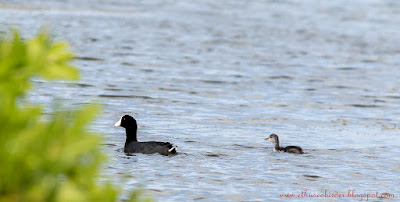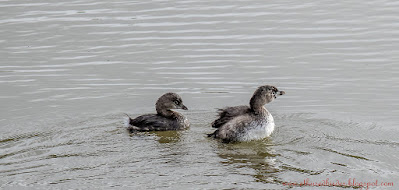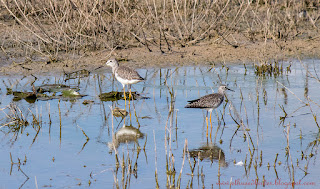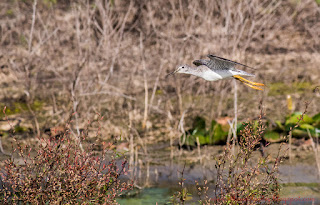Adapted from the blog The Enthusiastic Birder
The first week back to work after the “pause” was
surprisingly busy. It was good to be out
of the house after weeks of confinement but I was a little nervous, even a
little afraid because of the pervasiveness of COVID in society. The routine of mask and face
shield has become the norm for me, and disposable gloves are added to the mix
depending on where I am going. It was refreshing being outdoors, seeing the different birds
as I moved around the island. After work, on most of the days, I visited a few of the birding
hotspots, utilizing that activity for exercise as afforded by the government's COVID-19 protocols.
During that week I tallied 32 bird species
from 8 checklists, also adding 2 yearbirds namely Caribbean
Martin (Progne dominicensis), which
I saw in Bridgetown and Laughing Gulls
(Leucophaeus atricilla) at Pile
Bay. You can see the full list of the
birds I saw below.
I continue to be impressed with the Canon 7D Mark II, even as it is paired with the underwhelming (because of reach) Canon EF-s 55-250mm f/4 – 5.6 IS II, which effectively becomes 89.1 - 405mm (x1.62 crop sensor of the Canon 7D II). Here are a few highlight images for that week. All images were lightly edited using Adobe Lightroom CS2.
On March 1st I had my best look at a Merlin (Falco columbarius) for the year. It was going after Eurasian Collared-Doves (Streptopelia decaocto) for dinner, and while the shots I got were not ones I would normally highlight, I love this one that shows the beautiful barring pattern in this raptor's tail.
 |
| Merlin showing its tail feathers (1/4000 @ f8 ISO 1000 – 250mm) |
On the 3rd, my after work exercising took me to Chancery Lane
Swamp, Christ Church. While there, I tried to photograph an American Coot (Fulica Americana)
with her chicks. This was not an easy
task as both mum and chicks played peek-a-boo with me, using the mangroves for cover. While I easily got images of both of them alone, the image below was the only opportunity I had of them together.
 |
| Adult (1/1000 @ F/8 ISO 640 250mm) |
 |
| Juvenile (1/1000 @ F/8 ISO 640 250mm) |
 |
| Mother & Chick ((1/1250 @ F/8 ISO 640 250mm) |
The following day, the 4th, I ended work in the north so I visited the irrigation ponds at Bawdens, St. Andrew, and had a short photo session with a pair of Pied-billed Grebes
(Podilymbus podiceps).
 |
| Pied (1/1600 @ F/5.6 ISO 640 250mm) |
 |
The Pair (1/1250 @ F/8) ISO 640 250mm)
|
My last stop
for the week was at the Woodbourne
Shorebird Refuge (WSR) on Friday, March 5th. The water in
most of the ponds was evaporating making foraging by wading birds much
easier. This triggered a small feeding frenzy among various species of
waterbirds. In one pond I counted 7 species of heron/egrets tallying 22
birds, 6 species of shorebirds, and in another, 68 Blue-winged Teals (Spatula
discors), only a fraction of the 111 seen just a few days before. My most
exciting capture, though, was that of a Sora
(Porzana Carolina). This was the best look I’ve had of this shy bird for the
year. I would’ve love to get even lower but two things prevented that:
first, I would have to take my camera close to the water in the pond, too close
for my comfort. Even though it is weather-sealed I am not ready for that
adventure as yet with this babe. Secondly, I am always skeptical of
lying, sitting, walking in the grass, fields, or even the paved road in the
parish of St. Philip. It is notorious for its forty legs, its big, long,
ugly stinging CENTIPEDES and I don’t mess around with those things. Here
are a few of the images from WSR.
 |
Sora (1/1000 @ F/8) ISO 1000 250mm)
|
 |
Greater & Lesser Yellowlegs
(1/3200 @ F/8) ISO 1000 250mm)
|
 |
Lesser in flight (1/2500 @ F/8) ISO 1000 250mm)
|
 |
Little Egret in flight (1/5000 @ F/8) ISO 1000 250mm)
|
These are the birds I saw during the first week of March
- Black-bellied
Whistling-Duck - Dendrocygna autumnalis
- Blue-winged Teal - Spatula discors
- Green-winged Teal - Anas crecca
- Pied-billed Grebe - Podilymbus podiceps
- Scaly-naped Pigeon - Patagioenas squamosa
- Eurasian Collared-Dove - Streptopelia decaocto
- Common Ground Dove - Columbina passerina
- Sora - Porzana carolina
- Common Gallinule - Gallinula galeata
- American Coot - Fulica americana
- Least Sandpiper - Calidris minutilla
- Wilson's Snipe - Gallinago delicata
- Spotted Sandpiper - Actitis macularius
- Solitary Sandpiper - Tringa solitaria
- Greater Yellowlegs - Tringa melanoleuca
- Lesser Yellowlegs - Tringa flavipes
- Laughing Gull - Leucophaeus atricilla
- Royal Tern - Thalasseus maximus
- Red-billed Tropicbird - Phaethon aethereus
- Brown Booby - Sula leucogaster
- Great Egret - Ardea alba
- Little Egret - Egretta garzetta
- Snowy Egret - Egretta thula
- Little Blue Heron - Egretta caerulea
- Cattle Egret - Bubulcus ibis
- Green Heron - Butorides virescens
- Merlin - Falco columbarius
- Gray Kingbird - Tyrannus dominicensis
- Caribbean Martin - Progne dominicensis
- Carib Grackle - Quiscalus lugubris
- Grassland Yellow-Finch - Sicalis luteola
- Bananaquit - Coereba flaveola

























